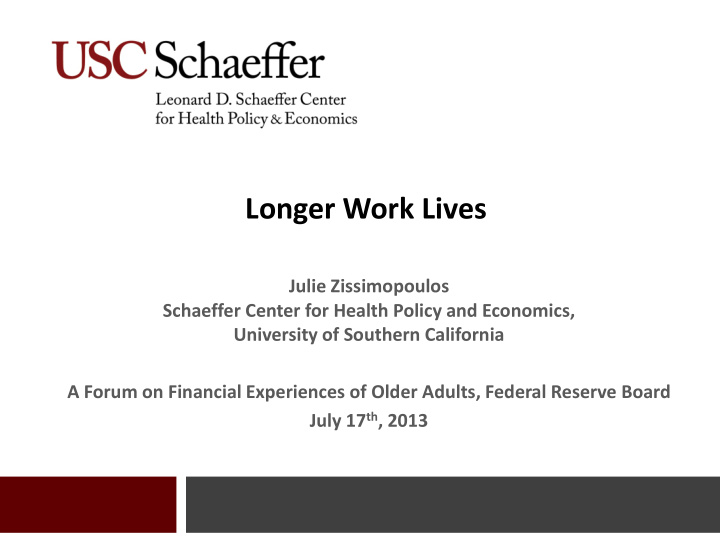



Longer Work Lives Julie Zissimopoulos Schaeffer Center for Health Policy and Economics, University of Southern California A Forum on Financial Experiences of Older Adults, Federal Reserve Board July 17 th , 2013
Middle Age and Older Workers Made Remarkable Changes in their Participation in the Work Force 100 90 80 70 Men 55-64 60 Men 65+ Percent 50 Women 55-64 40 Women 65+ 30 20 10 0 1950 1960 1970 1980 1990 2000 2010 2020 2030 Workforce participation rates of U.S. women and men, 1950- 2010, projected 2020-2030
Education, Technology, Longevity and Work by Women Are the Primary Reasons for Longer Work Lives 80 70 60 Men United States Percent in 50 Men OECD Labor Force 40 Women United States 30 Women OECD 20 10 0 1980 1985 1990 1995 2000 2005 Ages 55-64 Pension reform and employment protections may be secondary forces
Empirical Study Suggests that Older Workers Will Continue Working Longer Education level of older workers is rising More working women over age 45 - room to grow Forces Claiming age 67 for cohorts not yet retired at Play Greater longevity Changes to pension plans gaining momentum
Job Churning Among Older Workers is Common Today but Returning to Work is Challenging Only about one-half of older job searchers find work within two years – Data from a nationally representative sample over age 50 • Workforce policies may not well suited for older workers Policy has a role to plan • Need a better understanding of why individuals are involuntarily out of the labor force
Longer Work Lives Reduce Economic Challenges of an Aging Population 6.2 10 : 65 5 10 60 : 5.3 10 55 Ratio of non-workers : 50 to workers x 100 45 40 With flattening growth of the workforce (as in projections) 35 With the workforce continuing to grow 30 1990 2010 2030
Recommend
More recommend